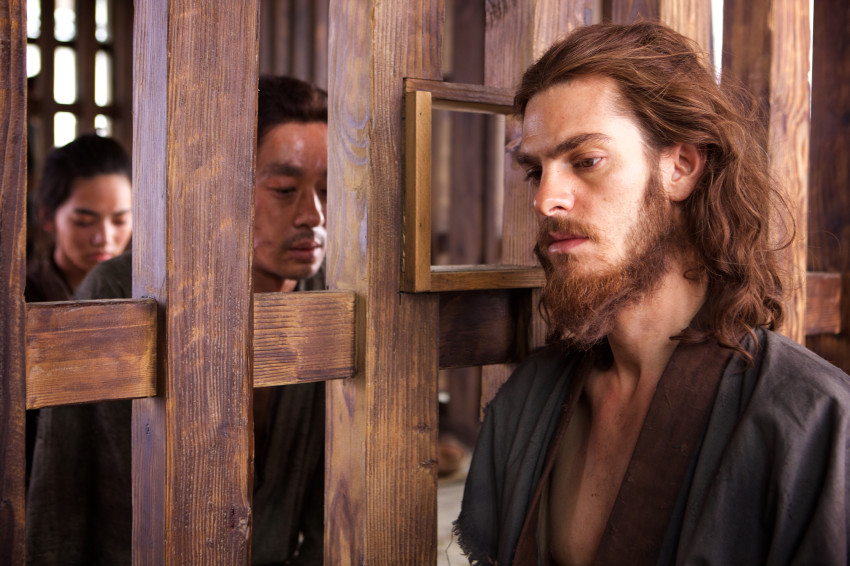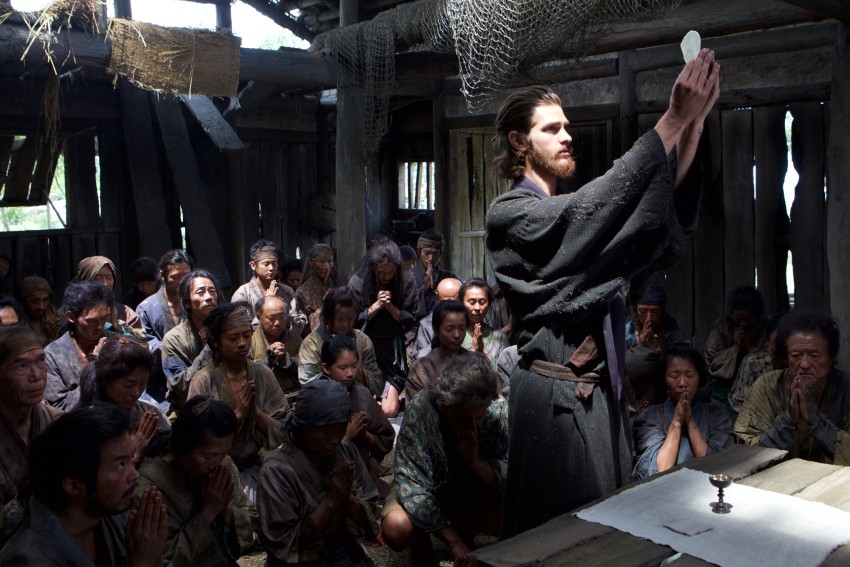Scorsese’s Silence
December 26, 2016 · 0 comments
by Jeremy Clarke.
 In the middle of Martin Scorsese’s new film Silence, a Japanese is made to dig a pit in the middle of a rainstorm. “How long will he be doing that?” asks Jesuit priest Father Rodrigues (Andrew Garfield) imprisoned nearby. “’Til he’s finished,” comes the reply.
In the middle of Martin Scorsese’s new film Silence, a Japanese is made to dig a pit in the middle of a rainstorm. “How long will he be doing that?” asks Jesuit priest Father Rodrigues (Andrew Garfield) imprisoned nearby. “’Til he’s finished,” comes the reply.
The speaker might be describing the film itself. Once Father Rodrigues and Father Garupe (Adam Driver) arrive in seventeenth century Japan, their journey of discovery as they search for the missing Father Ferreira (Liam Neeson) slowly and painstakingly proceeds towards its destination. Garupe disappears part way through the story leaving Rodrigues alone. A measured pace gives us time to observe the effect upon the two men as well as the ‘Hidden Christians’ they seek to serve. Neither priest is afraid to die for his faith, both have reckoned without the authorities’ plans to make them either renounce Christ or cause Japanese Christians to be tortured to death “This is easily done,” someone is told when asked to apostatise by stepping on a representation of Jesus. “It’s just an image.”
The Jesuits had brought the Christian Gospel to Japan and made many converts. Initially the country was sympathetic but later the ascendant Tokugawa Shogunate was keen to stamp out any trace of Christianity in Japan, torturing and killing believers who would not recant. Many went underground to practise their faith in secret as so-called ‘Hidden Christians’. The authorities were particularly keen to see any Western priests on Japanese soil renounce their faith.
The novel which inspired Scorsese’s film is considered the crowning achievement of author Shusaku Endo’s career. Originally published in Japan in 1966, the book came out in an English translation some three years later. It didn’t take long for film director Masahiro Shinoda, working from a script adapted by Endo himself, to produce a version which Jasper Sharp has described as “near-flawless.”
A generation later, Martin Scorsese was given a copy of the book at a screening of The Last Temptation Of Christ. His first reading made an immediate impression, grappling as the text did with deep issues of doubt and weakness in relation to faith. Scorsese decided he wanted to turn it into his next film and worked on a screenplay with Jay Cocks (The Age Of Innocence, Gangs of New York). However the director’s dissatisfaction with their original draft, coupled with difficulties in raising production finance meant that he would abandon then return to the project many times over the next three decades. Consequently, the Scorsese/Cocks script has marinated through several drafts in that time and is all the better for it.
Where Shinoda only shows the two searching priests, Scorsese also briefly portrays the object of their search, Father Ferreira. Liam Neeson brings a degree of gravitas to Ferreira, a feeling that everything we see the two younger priests go through is old news to him. The opening has Ferreira forced to watch members of his Christian flock tied to crosses while scalding hot spring water is dribbled upon them from large metal ladles. But will he renounce his faith to spare them? The two younger priests will be forced to watch similarly motivated tortures of Christians including crucifixion on coastal crosses in the face of incoming tides, and hanging upside-down over a pit with a lightly punctured neck so that the blood slowly drains out rather than pooling in the head. Elsewhere, Christians are bound in straw mats to be set alight on land or dropped into the sea and pushed under to drown.
 As with the tidal crucifixion, a number of sequences suggest the Christian ritual of baptism, often presented as lethal as believers are quite literally “baptised into the death of Christ” by water or fire. Perhaps the most poignant has the thirsty Father Rodrigues drink from a stream, and seeing Christ’s face momentarily replace his own reflection. Only then, he finds himself captured by the Japanese authorities following his betrayal by a Christian trying to save his own skin.
As with the tidal crucifixion, a number of sequences suggest the Christian ritual of baptism, often presented as lethal as believers are quite literally “baptised into the death of Christ” by water or fire. Perhaps the most poignant has the thirsty Father Rodrigues drink from a stream, and seeing Christ’s face momentarily replace his own reflection. Only then, he finds himself captured by the Japanese authorities following his betrayal by a Christian trying to save his own skin.
The remarkable supporting Japanese cast includes Issey Ogata as the ageing but feared Inquisitor Inoue, Tadanobu Asano as his devious interpreter and Shinya Tsukamoto as one of the doomed Christians. The latter cult director of Tetsuo The Iron Man and Bullet Ballet was determined to act in the film as a huge admirer of Scorsese. Apparently, the directorial admiration was mutual. Further cross-cultural influence took place in the cinematography, inspired by the work of Japanese cinematographer Kazuo Miyagawa on 1953’s Ugetsu Monogatari. Miyagawa’s other films as director of photography included Shinoda’s Silence.
For Scorsese, though, religion’s the thing. Why does God say nothing to these priests as they suffer? Is it because there’s no God and the whole thing is a gigantic con trip? Or is God suffering alongside them? And how are they supposed to cope with a society as apparently opposed to Christianity as seventeenth century Japan where, as it’s explained to them, the Son of God is understood to be the Sun of God who not only rose on the third day but rises unfailingly every morning? Struggling to understand all sides, Scorsese’s Silence successfully gets inside the heads of its Christian believers, both Western and Japanese, while managing to do the same with their persecutors. Altogether, a remarkable achievement.
Silence is released in the UK on 1st January 2017.
Leave a Reply